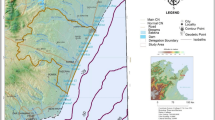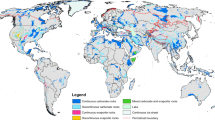Abstract
In the current study, the shuttle radar topography mission (SRTM) data, with ∼90 m horizontal resolution, were used to delineate the paleodrainage system and their mega basin extent in the East Sahara area. One mega-drainage basin has been detected, covering an area of 256 000 km2. It is classified into two sub mega basins. The Uweinate sub mega basin, which is composed of four main tributaries, collected water from a vast catchment region and drained eastward from the north, west, and southwest, starting at highland areas. The first subwatershed basin is in the northern plateau, south of the Abu-Balas area, with a total catchment area of 25 045 km2. The second subwatershed is in the Gilf Kebir plateau and has a total catchment area of 38 257 km2. The third subwatershed drains from the Uweinate highlands and has a catchment area of 46 154 km2. The fourth subwatershed, which is known in literature as Wadi Mokhtafi in its upper reach and Wadi Arid in its lower reach, drains the northwestern highlands of Sudan and has a total catchment area of 28 653 km2. The Tushka sub mega basin includes one watershed that drains from the northeast highlands of Sudan and has a total catchment area of 63 019 km2. The Uweinate and Tushka sub mega basins are joined together to the North of the Tushka depression, which drains northward toward the Kharga depression. This study indicates that the Eastern Sahara Mega Basin is a closed hydrological system independent of the other drainage systems, such as the Nile hydrosystem and the Qena Valley system. The present research illustrates the capability of the SRTM data in mapping the paleochannel networks, as well as estimate the catchment area and direction of the water flow. Finally, the study reveals that the four areas could be potentially used for different reclamation activities due to the ground water accumulations possibilities.
Similar content being viewed by others
References
Maxwell T, Haynes C V (2001) Sand sheet dynamics and Quaternary landscape evolution of the Selima Sand Sheet, southern Egypt [J]. Quaternary Science Reviews, 20: 1 623–1 647
McCauley J F, Breed C S, Schaber G G, et al. (1986) Paleodrainages of the Eastern Sahara—the radar rivers revisited. SIR A/B implications for a mid-tertiary trans-African drainage system [J]. IEEE Transactions on Geosciences and Remote Sensing,24: 624–648
El-Baz F, Mainguet M, Robinson C A, et al. (2000) Fluvio-aeolian dynamics in the North-eastern Sahara: interrelation between fluvial and aeolian systems and implications to ground water [J]. Journal of Arid Environments, 44: 173–183
Robinson C, El-Baz F, Ozdogan M, et al. (2000) Use of radar data to delineate palaeodrainage flow directions in the Selima Sand Sheet, Eastern Sahara[J]. Photogrammetric Engineering and Remote Sensing,66: 745–753
McCauley J F, Schaber G G, Breed C S, et al. (1982) Subsurface valleys and geoarchaeology of the Eastern Sahara revealed by shuttle radar [J]. Science, 218: 1 004–1 020
Ghoneim E, El-Baz F (2007) The application of radar topographic data to mapping of a mega-paleodrainage in the Eastern Sahara[J]. Journal of Arid Environments, 69(4): 658–675
Jensen S K, Domingue J O (1988) Extracting topographic structure from digital elevation model data for geographic information system analysis [J]. Photogrammetric Engineering and Remote Sensing, 54:1 593–1 600
Ghoneim E, Arnell N, Foody G, et al. (2002) Characterizing the flash flood hazards potential along the Red Sea Coast of Egypt [J]. The Extremes of the Extremes: Extraordinary Floods, 271: 211–216
Foody G, Ghoneim E, Arnell N,et al.(2004) Predicting locations sensitive to flash flooding in an arid environment [J]. Journal of Hydrology, 292:48–58
El-Baz F (1998) Sand accumulation and groundwater in the Eastern Sahara [J]. Episodes, 21: 147–151
Thorweihe U (1986) Isotopic identification and mass balance of the Nubian Aquifer System in Egypt [J]. Berliner Geowiss. Adh, 72(A): 3–16
Issawi B, McCauley J F (1992) The Cenozoic rivers of Egypt [M]// Friedman R, Adams B (Eds). The Followers of Horusin Studies in Memory of M.A. Hoffman, Oxford Monograph 20. Oxford: Oxbow Press
Schaber G G, McCauley J F, Breed C S,et al. (1997) The use of multifrequency and polarimetric SIR-C/X-SAR data in geologic studies of Bir Safsaf, Egypt [J]. Remote Sensing of the Environment, 59: 337–363
Sultan M, Sturchio N, Hassan F A, et al. (1997) Precipitation source inferred from stable isotopic composition of Pleistocene groundwater and carbonate deposits in the Western desert of Egypt [J]. Quaternary Geology, 4:29–37
Issawi B, El-Hinnawi M, Francis M, et al. (1999) The phanerozoic geology of Egypt [M]. A Geodynamic Approach. Geol. Surv. Egypt. Cairo: Special Publication
Grant J, Maxwell T, Johnson A,et al. (2004) Documenting drainage evolution in Bir Kiseiba, southern Egypt: constrains from ground-penetrating radar and implication for Mars [J]. Journal of Geophysical Research, 109: 1–7
Robinson C, El-Baz F, Al-Saud T, et al. (2006) Use of radar data to delineate palaeodrainage leading to the Kufra oasis in the Eastern Sahara [J]. Journal of African Earth Sciences, 44: 229–240
Pachur H J, Rottinger F (1997) Evidence for a large extended paleolake in the Eastern Sahara as revealed by spaceborne radar lab images [J]. Remote Sensing of Environment, 61: 437–440
Hoelzmann P, Keding B, Berke H, et al.(2001) Environmental change and archaeology: lake evolution and human occupation in the Eastern Sahara during the Holocene [J]. Palaeogeography, Palaeoclimatology, Palaeoecology, 169: 193–217
Wendorf F (1977) Late pleistocene and recent climatic changes in the Egyptian Sahara [J]. The Geographical Journal, 143(2): 211–234
El-Baz F (1982) Genesis of the great sand sea, Western desert of Egypt [C]. 11th International Conference, Hamilton, Ontario, Canada
Embabi N S (2004)The geomorphology of Egypt, landforms and evolution: the Nile Valley and the western desert [D]. The Egyptian Geographical Society
Breed C S, McCauley J F, Davis P A, et al. (1987) Sand sheets of eastern Sahara and ripple blankets on Mars[M]// Frostick L, Reid d I (Eds). Desert Sediments Ancient and Modern. London: Geological Society Special Publication
Burke K, Welles G L (1989) Trans-African drainage system of the Sahara: was it the Nile [J]. Geology, 17:743–747
Author information
Authors and Affiliations
Corresponding author
About this article
Cite this article
Youssef, A.M. Mapping the mega paleodrainage basin using shuttle radar topography mission in Eastern Sahara and its impact on the new development projects in Southern Egypt. Geo-spat. Inf. Sci. 12, 182–190 (2009). https://doi.org/10.1007/s11806-009-0057-8
Received:
Published:
Issue Date:
DOI: https://doi.org/10.1007/s11806-009-0057-8




